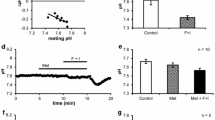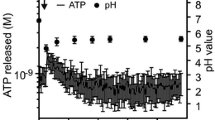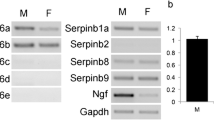Abstract
The expression of protein kinase C (PKC) isoforms and the modulation of Ca2+ mobilization by PKC were investigated in the human submandibular duct cell line A253. Three new PKC (nPKC) isoforms (δ, ε, and θ) and one atypical PKC (aPKC) isoform (λ) are expressed in this cell line. No classical PKC (cPKC) isoforms were present. The effects of the PKC activator phorbol 12-myristate-13-acetate (PMA) and of the PKC inhibitors calphostin C (CC) and bisindolymaleimide I (BSM) on inositol 1,4,5-trisphosphate (IP3) and Ca2+ responses to ATP and to thapsigargin (TG) were investigated. Pre-exposure to PMA inhibited IP3 formation, Ca2+ release and Ca2+ influx in response to ATP. Pre-exposure to CC or BSM slightly enhanced IP3 formation but inhibited the Ca2+ release and the Ca2+ influx induced by ATP. In contrast, pre-exposure to PMA did not modify the Ca2+ release induced by TG, but reduced the influx of Ca2+ seen in the presence of this Ca2+-ATPase inhibitor. These results suggest that PKC modulates elements of the IP3/Ca2+ signal transduction pathway in A253 cells by (1) inhibiting phosphatidylinositol turnover and altering the sensitivity of the Ca2+ channels to IP3, (2) altering the activity, the sensitivity to inhibitors, or the distribution of the TG-sensitive Ca2+ ATPase, and (3) modulating Ca2+ entry pathways.
Similar content being viewed by others
References
Pinkstaff CA: The cytology of salivary glands. Int Rev Cytol 63: 141–261, 1980
Denniss AR, Young JA: The action of neurotransmitter hormones and analogues and cyclic nucleotide and theophylline on electrolyte transport by the excretory duct of the rabbit mandibular gland. Pflügers Arch 357: 77–89, 1975
Evans RL, Lau KR, Case RM: Structural and functional characterization of striated ducts isolated from the rabbit mandibular salivary gland. Exp Phyiol 78: 49–64, 1993
Dinudom A, Komwatana P, Young JA, Cook DI: A forskolin-activated Cl– current in mouse mandibular duct cells. Am J Physiol 268: G806–G812, 1995
Field MJ, Young JA: Kinetics of Na transport in the rat submaxillary main duct perfused in vitro. Pflügers Arch 345: 207–220, 1973
Martin CJ, Frömter E, Gebler E, Knauf B, Young JA: The effects of carbachol on water and electrolyte fluxes and transepithelial electrical potential differences of the rabbit submanxillary main duct perfused in vitro. Pflügers Arch 341: 131–142, 1973
Valdez IH, Turner RJ: Effects of secretagogues on cytosolic Ca2+ levels in rat submandibular granular ducts and acini. Am J Physiol 261: G359–G363, 1991
Dinudom A, Poronnik P, Allen DG, Young JA, Cook DI: Control of intracellular Ca2+ by adrenergic and muscarinic agonist in mouse mandibular ducts and endpieces. Cell Calcium 14: 631–638, 1993
Berridge MJ: Inositol trisphosphate and diacylglycerol: Two interacting second messengers. Ann Rev Biochem 56: 159–193, 1987
Newton AC: Protein kinase C: Structure, function, and regulation. J Biol Chem 270: 28495–28498, 1995
Nishizuka Y: Protein kinase C and lipid signaling for sustained cellular responses. FASEB J 9: 484–496, 1995
Berrie CP, Elliott AC: Activation of protein kinase C does not cause desensitization in rat and rabbit mandibular acinar cells. Pflügers Arch 428: 163–172, 1994
Mörk A-C, Zhang GH, Martinez JR: Modulation of Ca2+ mobilization by protein kinase C in rat submandibular acinar cells. J Cell Biochem 72: 47–55, 1999
Martinez JR, Zhang GH: Cross-talk in signal transduction pathways of rat submandibular acinar cells. Eur J Morphol 36(suppl): 190–193, 1998
He XJ, Wu XZ, Baum BJ: Protein kinase C differentially inhibits muscarinic receptor operated Ca2+ release and entry in human salivary cells. Biochem Biophys Res Commun 152: 1062–1069, 1988
Sando JJ, Maurer MC, Bolen EJ, Grisham CM: Role of cofactors in protein kinase C activation. Cell Signal 4: 595–609, 1992
Terzian AR, Rubin RP: Translocation of the α-isozyme of protein kinase C during stimulation of rat parotid acinar cells by phorbol ester and carbachol. Arch Oral Biol 38: 1051–1056, 1993
Giard DJ, Aaronson SA, Todaro GJ, Arnstein P, Kersey JH, Dosik H, Parks WP: In vitro cultivation of human tumors: Establishment of cell lines derived from a series of solid tumors. J Natl Cancer Inst 51: 1417–1423, 1973
Roomans GM: Chloride transport in a human submandibular gland cell line studied by X-ray microanalysis. Eur J Morphol 36(suppl): 132–136, 1998
Zhang GH, Helmke RJ, Martinez JR: Characterization of Ca2+ mobilization in the human submandibular duct cell line A253. Proc Soc Exp Biol Med 216: 117–124, 1997
Grynkiewicz G, Poenie M, Tsien RY: A new generation of Ca2+ indicators with greatly improved fluorescence properties. J Biol Chem 260: 3440–3450, 1985
Wells J, Zhang GH, Martinez JR: Comparison of calcium mobilization in response to noradrenaline and acetylcholine in submandibular cells of newborn and adult rats. Arch Oral Biol 42: 633–640, 1997
Chakravarthy BR, Tremblay R, MacDonald P, Krsmanovic V, Whitfield JF, Durkin JP: The activation of inactive membrane-associated protein kinase C is associated with DMSO-induced erythroleukemia cell differentiation. Biochim Biophys Acta 1136: 83–90, 1992
Kobayash E, Nakano H, Morimoto M, Tamaoki T: Calphostin C (UCN-1028C), a novel microbial compound, is a highly potent and specific inhibitor of protein kinase C. Biochem Biophys Res Commun 159: 548–553, 1989
Toullec D, Pianetti P, Coste H, Bellevergue P, Grand-Perret T, Ajakane M, Baudet V, Boissin P, Boursier E, Loriolle F, Duhame L, Charon D, Kirilovsky J: The bisindolymaleimide GF 109203X is a potent and selective inhibitor of protein kinase C. J Biol Chem 266: 15771–15781, 1991
Akiguchi I, Izumi M, Nagataki S: Effects of phorbol ester on protein kinase C activity and effects of depletion of its activity on the thyrotrophin, forskolin and 8′-bromoadenosine 3′,5′-cyclic monophosphate-induced [3H]thymidine incorporation in rat FRTL-5 cells. J Endocrinol 138: 379–389, 1993
Zhang GH, Martinez JR: Effects of forskolin, dibutyryl cAMP and H89 on Ca2+ mobilization in submandibular cells of newborn rats. Arch Oral Biol (submitted)
Xu X, Diaz J, Zhao H, Muallem S: Characterization, localization and axial distribution of Ca2+ signaling receptors in the rat submandibular salivary gland ducts. J Physiol 491: 647–662, 1995
Kraus-Friedmann N: Calcium sequestration in the liver. Cell Calcium 11: 625–640, 1990
Putney JW Jr: Capacitative calcium entry revisited. Cell Calcium 11: 611–624, 1990
Putney JW Jr, Bird GSTJ: The inositol phosphate-calcium signaling system in nonexcitable cells. Endocrinol Rev 14: 610–631, 1993
Gaur S, Yamaguchi H, Goodman HM: Growth hormone increases calcium uptake in rat fat cells by a mechanism dependent on protein kinase C. Am J Physiol 270: C1485–C1492, 1996
Sakai T, Ambudkar IS: Role for protein kinases in Ca2+-dependent feedback modulation of divalent cation influx internal-Ca2+-store-depleted rat parotid gland cells. Pflügers Arch 433: 464–471, 1997
Author information
Authors and Affiliations
Rights and permissions
About this article
Cite this article
Sugita, K., Mörk, AC., Zhang, G.H. et al. Modulation of Ca2+ mobilization by protein kinase C in the submandibular duct cell line A253. Mol Cell Biochem 198, 39–46 (1999). https://doi.org/10.1023/A:1006925408055
Issue Date:
DOI: https://doi.org/10.1023/A:1006925408055




